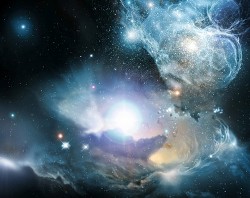Mar 18 2010
Astronomers have discovered what appear to be two of the earliest and most primitive supermassive black holes known.
 What did the first supermassive black holes -- the first quasars -- look like? The very early universe didn't have any dust, so the most primitive quasars also should be dust-free. But nobody had seen such pristine quasars until recently, when the Spitzer telescope spied two of them about 13 billion light-years away.
What did the first supermassive black holes -- the first quasars -- look like? The very early universe didn't have any dust, so the most primitive quasars also should be dust-free. But nobody had seen such pristine quasars until recently, when the Spitzer telescope spied two of them about 13 billion light-years away.
The discovery, based on observations with the NASA's Spitzer Space Telescope and other space observatories, will be published in the March 18 edition of the scientific journal Nature.
Black holes are beastly distortions of space and time. The most massive and active ones lurk at the cores of galaxies, and are usually surrounded by doughnut-shaped structures of dust and gas that feed and sustain the growing black holes. These hungry supermassive black holes are called quasars.
The very early universe didn't have any dust, so the most primitive quasars also should be dust-free. But nobody had seen such pristine quasars -- until now, when the Spitzer telescope spied two of them about 13 billion light-years away. The findings will help astronomers understand the roots of our universe, and how the very first black holes, galaxies and stars all came to be.
"The main goal of this collaboration is to determine if these very first quasars -- which are very distant from Earth in space and time -- are feeding and growing in the same way as do quasars that are closer to Earth," said Niel Brandt, professor of astronomy and astrophysics at Penn State University. "We have found what are likely first-generation quasars, born in a dust-free medium and at the earliest stages of evolution," said Linhua Jiang of University of Arizona, Tucson. Jiang is the first author of the research paper.
This paper is one result of a decade-long collaboration to measure a wide range of energies emitted by the first quasars to form in the universe -- energies low as infrared to as high as X-rays. Brandt's research group has led much of the X-ray work in this collaboration, and has discovered that the X-ray emission from the first quasars is remarkably similar to that of quasars that are much closer to Earth.
X-rays, ultraviolet light and optical light stream out from quasars as these supermassive black holes consume the gas surrounding them, a process called accretion.
"For about a decade, our X-ray and optical measurements have provided increasingly strong evidence that the inner accretion flows of the first quasars are remarkably similar to those of garden-variety quasars in the local universe. It thus is unexpected and exciting to find a small number of quasars that, in their infrared properties, clearly differ from local objects," Brandt said.
"Quasars emit enormous amount of light, making them detectable literally at the edge of observable universe," said Xiaohui Fan, a coauthor of the paper at the University of Arizona. The two quasars, called J0005-0006 and J0303-0019, were first discovered by Fan, Jiang and their colleagues in 2004 and 2007 using visible-light data from the Sloan Digital Sky Survey. NASA's Chandra X-ray Observatory also had observed X-rays from one of the objects in 2005. Fan's research group led the infrared work in this collaboration.
When the astronomy team set out to observe J0005-0006 and J0303-0019 with Spitzer between 2006 and 2009, the objects didn't stand out much from the usual quasar bunch. Spitzer measured infrared light from the two objects along with 18 others, all belonging to a class of the most distant quasars known. Each quasar is anchored by a supermassive black hole weighing more than 100 million suns.
The Spitzer data showed that, of the 20 quasars, J0005-0006 and J0303-0019 lacked the characteristic signatures of hot dust. Spitzer's infrared sight makes it ideally suited to detect the warm glow of dust that has been heated by the feeding black holes.
"We think these early black holes are forming around the time when dust was first forming in the universe, less than one billion years after the Big Bang," said Fan. "The primordial universe did not contain any molecules that could coagulate to form dust. The elements necessary for this process were produced and pumped into the universe later by stars."
The astronomers also observed that the amount of hot dust in a quasar increased with the mass of its black hole. As a black hole grows, dust has more time to build up around it. J0005-0006 and J0303-0019 have the smallest black holes known in the early universe, indicating they are particularly young, and at a stage when dust has not yet formed around them.